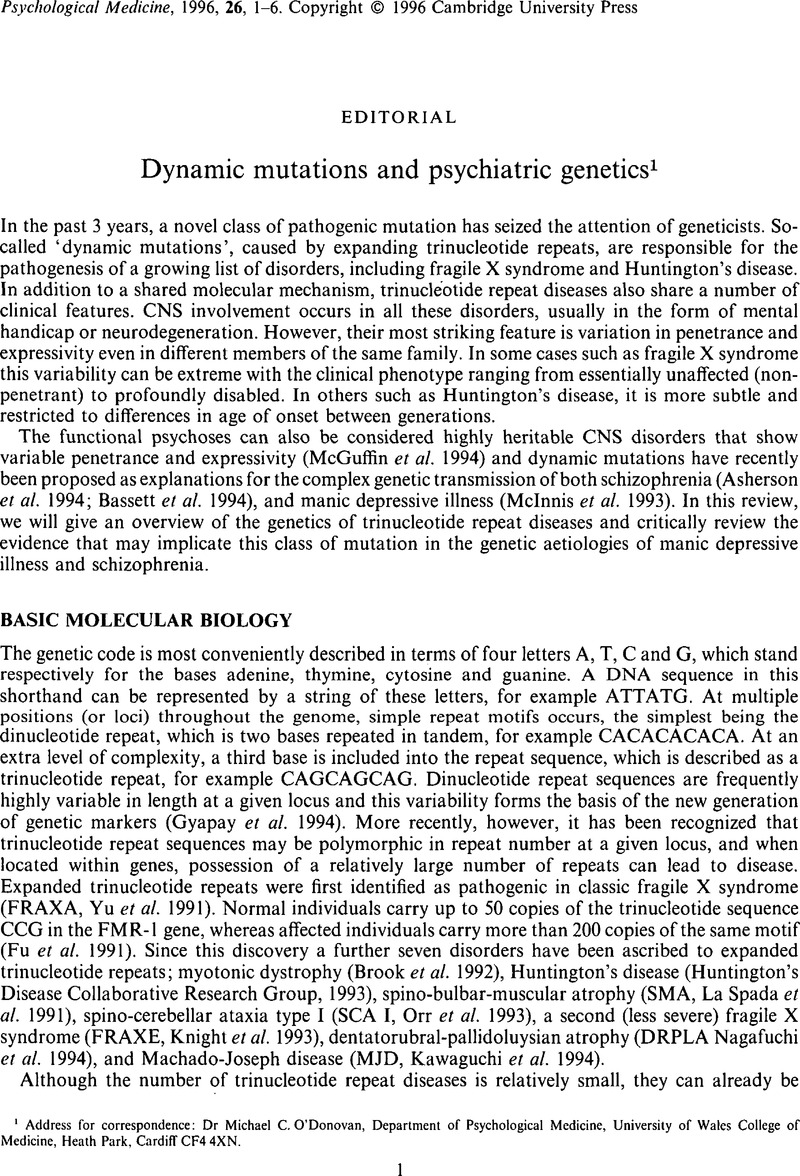Crossref Citations
This article has been cited by the following publications. This list is generated based on data provided by Crossref.
Cardno, Alastair G.
Murphy, Kieran C.
Jones, Lisa A.
Guy, Carol A.
Asherson, Philip
De Azevedo, Maria H. P.
Da Cruz Coelho, Isabel M. O.
De Macedo e Santos, Antonio J. F.
Pato, Carlos N.
McGuffin, Peter
Owen, Michael J.
and
O'Donovan, Michael C.
1996.
Expanded CAG/CTG Repeats in Schizophrenia.
British Journal of Psychiatry,
Vol. 169,
Issue. 6,
p.
766.
O'Donovan, Michael C
Craddock, Nick
Guy, Carol
McGuffin, Peter
and
Owen, Michael
1996.
Involvement of expanded trinucleotide repeats in common diseases.
The Lancet,
Vol. 348,
Issue. 9043,
p.
1739.
O'Donovan, M. C.
Guy, C.
Craddock, N.
Bowen, T.
McKeon, P.
Macedo, A.
Maier, W.
Wildenauer, D.
Aschauer, H. N.
Sorbi, S.
Feldman, E.
Mynett-Johnson, L.
Claffey, E.
Nacmias, B.
Valente, J.
Dourado, A.
Grassi, E.
Lenzinger, E.
Heiden, A. M.
Moorhead, S.
Harrison, D.
Williams, J.
McGuffin, P.
and
Owen, M. J.
1996.
Confirmation of association between expanded CAG/CTG repeats and both schizophrenia and bipolar disorder.
Psychological Medicine,
Vol. 26,
Issue. 6,
p.
1145.
Craddock, Nick
1996.
Psychiatric Genetics.
British Journal of Psychiatry,
Vol. 169,
Issue. 3,
p.
386.
Craddock, Nick
McKeon, Patrick
Moorhead, Steve
Guy, Carol
Harrison, Dale
Mynett-Johnson, Lesley
Claffey, Eileen
Feldman, Eleanor
McGuffin, Peter
Owen, Michael J.
and
O'Donovan, Michael C.
1997.
Expanded CAG/CTG repeats in bipolar disorder: No correlation with phenotypic measures of illness severity.
Biological Psychiatry,
Vol. 42,
Issue. 10,
p.
876.
Speight, Graham
Guy, Carol
Bowen, Timothy
Asherson, Phillip
McGuffin, Peter
Craddock, Nick
Owen, Michael J.
and
O'Donovan, Michael C.
1997.
Exclusion of CAG/CTG trinucleotide repeat loci which map to chromosome 4 in bipolar disorder and schizophrenia.
American Journal of Medical Genetics,
Vol. 74,
Issue. 2,
p.
204.
Li, Tao
Vallada, Homero P.
Liu, Xiehe
Xie, Tao
Tang, Xiangdong
Zhao, Jinghua
O’Donovan, Michael C.
Murray, Robin M.
Sham, Pak C.
and
Collier, David A.
1998.
Analysis of CAG/CTG repeat size in chinese subjects with schizophrenia and bipolar affective disorder using the repeat expansion detection method.
Biological Psychiatry,
Vol. 44,
Issue. 11,
p.
1160.
Fernández, G.
Effenberger, O.
Vinz, B.
Steinlein, O.
Elger, C. E.
Döhring, W.
and
Heinze, H. J.
1998.
Hippocampal malformation as a cause of familial febrile convulsions and subsequent hippocampal sclerosis.
Neurology,
Vol. 50,
Issue. 4,
p.
909.
Guy, C.A.
Bowen, T.
Williams, N.
Jones, I.R.
McCandless, F.
McGuffin, P.
Owen, M.J.
Craddock, N.
and
O'Donovan, M.C.
1999.
No association between a polymorphic CAG repeat in the human potassium channel gene hKCa3 and bipolar disorder.
American Journal of Medical Genetics,
Vol. 88,
Issue. 1,
p.
57.
O’Donovan, M. C.
and
McGuffin, P.
1999.
Psychiatrie der Gegenwart 1.
p.
109.
O'Donovan, M.C.
and
Owen, M.J.
1999.
Candidate-Gene Association Studies of Schizophrenia.
The American Journal of Human Genetics,
Vol. 65,
Issue. 3,
p.
587.
Bowen, Timothy
Ashworth, Lindsay
Kirov, George
Guy, Carol A
Jones, Ian R
McCandless, Fiona
Craddock, Nick
O'donovan, Michael C
and
Owen, Michael J
2000.
No evidence of association from transmission disequilibrium analysis of the hKCa3 gene in bipolar disorder.
Bipolar Disorders,
Vol. 2,
Issue. 4,
p.
328.
Baron, M
2002.
Manic-depression genes and the new millennium: poised for discovery.
Molecular Psychiatry,
Vol. 7,
Issue. 4,
p.
342.
O'Donovan, Michael
2006.
Encyclopedia of Life Sciences.
Tew, J.
Ramon, S.
Slade, M.
Bird, V.
Melton, J.
and
Le Boutillier, C.
2012.
Social Factors and Recovery from Mental Health Difficulties: A Review of the Evidence.
British Journal of Social Work,
Vol. 42,
Issue. 3,
p.
443.
2017.
Catatonia and Schizophrenia: A Case Report.
International Journal of Psychiatry,
Vol. 2,
Issue. 1,





